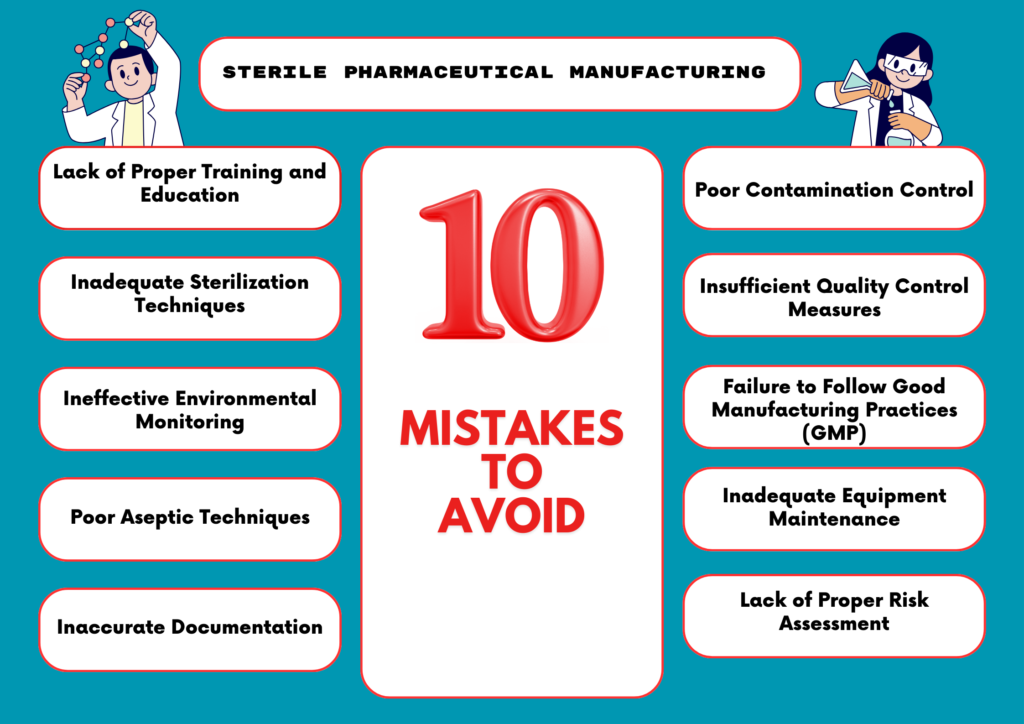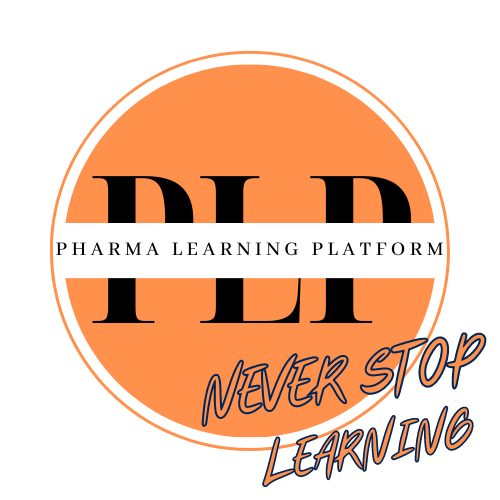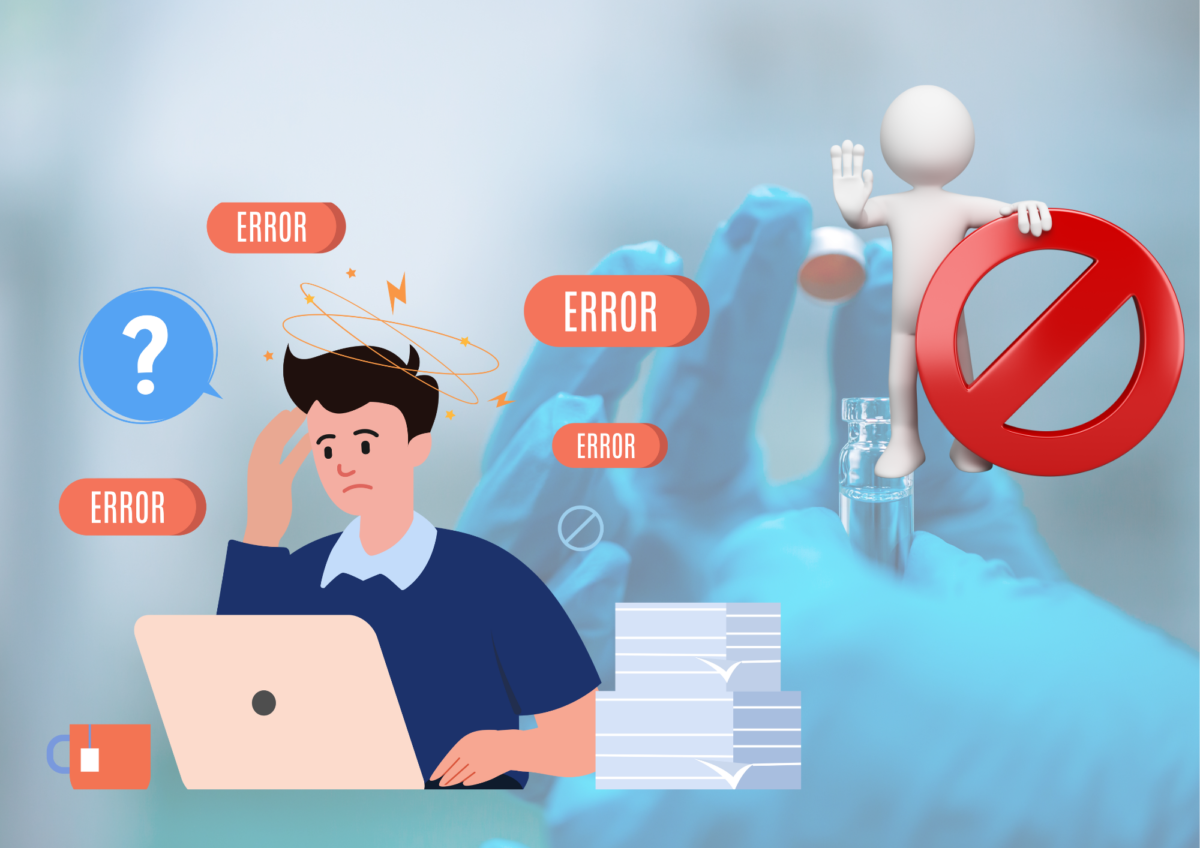When it comes to manufacturing sterile pharmaceuticals, attention to detail and adherence to strict protocols are paramount. Any mistakes or errors in the process can have serious consequences, compromising the safety and efficacy of the final product. In this article, we will discuss ten common mistakes to avoid in sterile pharmaceutical manufacturing, along with the importance of addressing them.
Lack of Proper Training and Education
One of the most critical mistakes in sterile pharmaceutical manufacturing is the lack of proper training and education for personnel involved in the process. It is essential to have well-trained individuals who understand the importance of following standard operating procedures (SOPs) and are knowledgeable about the specific requirements and criticality of sterile manufacturing.

Ongoing education and skill development are also crucial to ensure that personnel stay updated with the latest advancements in sterile manufacturing techniques. Regular training sessions and workshops can help reinforce proper practices and improve overall competency.
Inadequate Sterilization Techniques
Another common mistake is the use of inadequate sterilization techniques. Sterilization is a critical step in the manufacturing process to eliminate any microbial contamination. It is vital to follow proper sterilization methods, such as steam sterilization, dry heat sterilization, or filtration, depending on the specific requirements of the product.
Common mistakes in sterilization techniques include improper temperature or pressure settings, insufficient sterilization time, and failure to validate the effectiveness of the sterilization process. These mistakes can lead to compromised product quality and pose a risk to patient safety.
Ineffective Environmental Monitoring
Maintaining a sterile environment is crucial in pharmaceutical manufacturing. Ineffective environmental monitoring can lead to contamination and compromise the quality of the final product. It is essential to regularly monitor critical parameters such as air quality, surface cleanliness, and particulate levels.
Common mistakes in environmental monitoring include inadequate sampling methods, improper placement of monitoring devices, and failure to address deviations promptly. Implementing a robust environmental monitoring program and addressing any deviations promptly are essential to ensure a controlled and sterile manufacturing environment.
Poor Aseptic Techniques
Aseptic techniques are necessary to prevent the introduction of microbial contaminants during the manufacturing process. Poor aseptic techniques can lead to contamination of the product and compromise its sterility. It is crucial to train personnel on proper gowning procedures, hand hygiene, and aseptic manipulations.
Common mistakes in aseptic techniques
- Inadequate hand hygiene: Proper hand hygiene is essential to prevent the transfer of microorganisms. Failure to wash hands thoroughly or use appropriate sanitizers can introduce contaminants into the manufacturing process.
- Improper gowning: Wearing appropriate sterile gowns, gloves, masks, and hair covers is necessary to minimize the risk of contamination. Failing to follow the correct gowning procedures or wearing contaminated attire can compromise the aseptic environment.
- Inadequate disinfection: Surfaces and equipment must be thoroughly disinfected to eliminate any potential sources of contamination. Neglecting to properly clean and disinfect work areas, equipment, and tools can introduce harmful microorganisms.
- Poor technique in aseptic transfers: Transferring materials between containers or from one area to another requires careful attention to prevent contamination. Mishandling of sterile components, improper use of transfer devices, or failure to maintain sterility during transfers can compromise the product.
- Failure to maintain proper airflow: Airflow is critical in maintaining a controlled environment. Improper ventilation or failure to monitor and maintain appropriate air pressure differentials can result in the introduction of contaminants.
Inaccurate Documentation
Accurate and detailed documentation is essential in sterile pharmaceutical manufacturing. It provides a record of the entire manufacturing process, including critical parameters, deviations, and corrective actions taken. Inaccurate or incomplete documentation can lead to compliance issues and make it challenging to identify and address potential problems.
Common mistakes in documentation practices include failure to record critical data, incomplete or illegible entries, and inadequate review and approval processes. Implementing a robust documentation system, including electronic batch records and proper training on documentation practices, can help ensure accuracy and compliance.
Poor Contamination Control
Implement effective contamination control measures to prevent contamination in the manufacturing environment. Poor contamination control in a manufacturing environment can lead to a variety of detrimental consequences, impacting product quality, worker safety, regulatory compliance, and overall operational efficiency.
Here are some key consequences:
Product Quality Issues: Contamination can introduce foreign particles, microorganisms, or chemicals into products, leading to defects, product recalls, or even product failures. This can result in financial losses, damage to reputation, and loss of customer trust.
Health and Safety Risks: Contaminants in the manufacturing environment pose risks to the health and safety of workers. Exposure to harmful substances or pathogens can lead to illnesses, injuries, or long-term health effects. Failure to adequately control contamination may also result in workplace accidents, such as slips and falls.
Regulatory Non-Compliance: Many industries are subject to strict regulations regarding contamination control to ensure product safety and quality. Failure to comply with these regulations can result in fines, penalties, or legal actions from regulatory agencies. Non-compliance may also lead to the suspension or revocation of operating licenses or certifications.
Increased Production Costs: Dealing with contamination-related issues such as product recalls, rework, or disposal of contaminated materials can significantly increase production costs. Moreover, implementing corrective measures to address contamination problems, such as equipment cleaning, sanitization, or facility upgrades, requires additional resources and time.
Downtime and Production Delays: Contamination incidents often require halting production processes for investigation, cleaning, and corrective actions. This downtime can lead to delays in fulfilling orders, disruptions in supply chains, and loss of revenue. In severe cases, prolonged production interruptions may impact contractual obligations and customer relationships.
Poor contamination control not only affects the immediate operational aspects of a manufacturing facility but also has far-reaching implications for quality, safety, compliance, and sustainability, ultimately impacting the bottom line and the long-term viability of the business.
Insufficient Quality Control Measures
Rigorous quality control measures are necessary to ensure that the final product meets the required quality standards. Insufficient quality control can lead to the release of substandard or contaminated products, posing a risk to patient safety.
Common mistakes in quality control measures
- Inadequate testing protocols: Testing protocols should be comprehensive and aligned with regulatory requirements. Failure to establish appropriate testing procedures can result in undetected quality issues.
- Lack of sampling and testing frequency: Regular sampling and testing are crucial to ensure consistent product quality. Insufficient frequency or sample size can lead to inaccurate representation of the batch and potential undetected issues.
- Failure to calibrate and maintain testing equipment: Calibration and maintenance of testing equipment is essential to ensure accurate and reliable results. Neglecting to calibrate or properly maintain equipment can lead to erroneous measurements and compromised quality control.
- Insufficient training of quality control personnel: Proper training of quality control personnel is necessary to perform accurate testing and analysis. Inadequate training can result in errors or inconsistencies in quality control practices.
- Lack of adherence to release criteria: Products should only be released if they meet predetermined quality criteria. Failure to adhere to release criteria can result in the distribution of substandard or contaminated products.
Failure to Follow Good Manufacturing Practices (GMP)
Good Manufacturing Practices (GMP) provide a framework for ensuring the quality and safety of pharmaceutical products. Failure to follow GMP guidelines can result in non-compliance issues and compromise the integrity of the final product.
Common mistakes in GMP compliance
- Lack of written procedures: Clear and comprehensive written procedures are necessary to guide manufacturing processes. Failing to establish proper procedures can lead to inconsistencies and non-compliance with GMP requirements.
- Inadequate employee training: Training employees on GMP requirements and expectations is crucial to ensure compliance. Insufficient training can result in non-compliance and compromised product quality.
- Failure to conduct regular audits and inspections: Regular audits and inspections are essential to identify areas of non-compliance and implement corrective actions. Neglecting to conduct audits or inspections can result in ongoing non-compliance and potential quality issues.
- Poor facility design and layout: The design and layout of the manufacturing facility should facilitate proper flow of materials and personnel, prevent cross-contamination, and ensure aseptic conditions. Inadequate facility design can lead to non-compliance with GMP requirements.
- Lack of sanitation and hygiene practices: Maintaining a clean and hygienic manufacturing environment is crucial in GMP compliance. Failure to implement proper sanitation and hygiene practices can result in contamination and non-compliance.
Inadequate Equipment Maintenance
Well-maintained equipment is crucial for ensuring the quality and safety of sterile pharmaceuticals. Inadequate equipment maintenance can lead to breakdowns, deviations in process parameters, and compromised product quality.
Common mistakes in equipment maintenance include infrequent or improper cleaning, lack of regular calibration, and failure to address equipment issues promptly. Implementing a preventive maintenance program and conducting regular inspections can help ensure the proper functioning of equipment and minimize the risk of errors.
Lack of Proper Risk Assessment
Conducting risk assessments is essential in sterile pharmaceutical manufacturing to identify potential hazards and implement appropriate controls. A lack of proper risk assessment can result in unidentified risks and potential failures in the manufacturing process.
Common mistakes in risk assessment processes
- Inadequate identification of potential risks: Failing to identify all potential risks can result in overlooking critical factors that may impact product quality and safety.
- Insufficient analysis of risk severity: Proper assessment of the severity of identified risks is necessary to prioritize mitigation efforts. Inaccurate or incomplete analysis can lead to ineffective risk management strategies.
- Failure to implement appropriate risk control measures: Once risks are identified, appropriate control measures should be implemented to minimize their impact. Neglecting to implement or ineffective implementation of control measures can leave the manufacturing process vulnerable to errors or contamination.
- Lack of regular review and update of risk assessments: Risk assessments should be periodically reviewed and updated to reflect changes in processes, equipment, or regulations. Failure to regularly review and update risk assessments can result in outdated or ineffective risk management strategies.
- Inadequate involvement of cross-functional teams: Risk assessments should involve input from various stakeholders, including production, quality control, and engineering teams. Excluding key stakeholders can result in overlooking important perspectives and potential risks.
�
Recap of the 10 mistakes to avoid in sterile pharmaceuticals
Recap of the 10 mistakes to avoid in sterile pharmaceuticals:
In this blog post, we have discussed the 10 common mistakes to avoid in sterile pharmaceuticals. Let’s recap them briefly:
- Lack of Proper Training and Education: Ensure that your personnel are well-trained and educated in sterile manufacturing processes. Ongoing education and skill development are crucial to maintaining high-quality standards.
- Inadequate Sterilization Techniques: Use proper sterilization methods to eliminate any microbial contamination. Avoid common mistakes such as incomplete sterilization or improper use of sterilization equipment.
- Ineffective Environmental Monitoring: Regularly monitor the sterile environment to ensure cleanliness and prevent contamination. Avoid mistakes like insufficient monitoring or improper handling of environmental samples.
- Poor Aseptic Techniques: Maintain aseptic conditions during manufacturing to prevent microbial contamination. Be aware of common mistakes like improper gowning, improper hand hygiene, or inadequate cleanroom practices.
- Inaccurate Documentation: Accurate and detailed documentation is essential for quality control and regulatory compliance. Avoid mistakes such as incomplete or incorrect documentation, as it can lead to compliance issues.
- Poor Contamination Control: Implement effective contamination control measures to prevent contamination in the manufacturing environment. Avoid mistakes like improper cleaning and disinfection practices or inadequate control of personnel and material flow.
- Insufficient Quality Control Measures: Implement robust quality control measures to ensure the safety and efficacy of sterile pharmaceuticals. Avoid mistakes like inadequate testing, improper sampling, or lack of quality control protocols.
- Failure to Follow Good Manufacturing Practices (GMP): Adhere to GMP guidelines to ensure consistent and high-quality manufacturing processes. Avoid mistakes like non-compliance with GMP regulations or overlooking critical GMP requirements.
- Inadequate Equipment Maintenance: Regularly maintain and calibrate equipment to ensure optimal performance. Avoid mistakes such as neglecting equipment maintenance or failing to address equipment issues promptly.
- Lack of Proper Risk Assessment: Conduct thorough risk assessments to identify and mitigate potential risks in the sterile manufacturing process. Avoid mistakes like overlooking critical risks or not implementing appropriate risk control measures.
In conclusion, the field of sterile pharmaceuticals requires meticulous attention to detail and adherence to best practices. By avoiding these 10 mistakes, you can enhance the quality and safety of your sterile pharmaceutical manufacturing processes. Stay informed, continuously improve your knowledge and skills, and always prioritize the well-being of patients when working with sterile pharmaceuticals.

